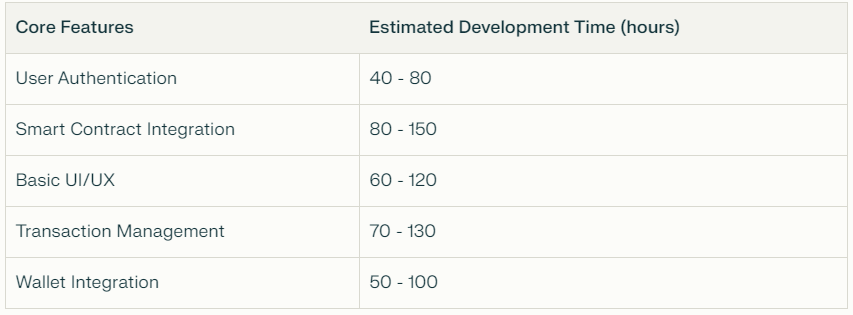
Decentralized applications (DApps) have gained significant traction in recent years, particularly within the Ethereum ecosystem. As businesses and startups explore the potential of blockchain technology, understanding the cost of developing a DApp becomes essential. This blog aims to provide a comprehensive overview of the factors influencing Ethereum DApp development costs, making it easier for businesses and potential clients to make informed decisions.
Understanding DApps
DApps are applications that run on a blockchain network rather than being hosted on centralized servers. This decentralized nature offers several advantages, including enhanced security, transparency, and user control over data. However, building a DApp involves various complexities that can impact development costs.
Key Factors Influencing Development Costs
The cost of developing a DApp is not fixed; it varies based on several factors:
Complexity of the Application: The more complex the DApp, the higher the cost. Simple applications with basic functionalities will generally be less expensive than those requiring advanced features.
Technology Stack: The choice of programming languages and frameworks can significantly affect costs. For instance, using widely adopted technologies like Solidity for smart contracts may streamline development compared to niche technologies that require specialized expertise.
Development Team Location: The geographical location of your development team plays a crucial role in determining costs. Rates can vary significantly between regions due to differences in living costs and market demand for IT specialists.
Security Measures: Given the financial implications associated with vulnerabilities in smart contracts, investing in robust security measures is essential. This includes smart contract audits and penetration testing, which can add to overall costs.
User Interface (UI) and User Experience (UX) Design: A well-designed UI/UX is critical for user engagement. Investing in professional design services can enhance usability but also contribute to higher development costs.
Types of DApps and Their Cost Implications
Different types of DApps come with varying complexity levels and associated costs:
Simple DApps: These typically include basic token management functionalities and require minimal smart contract integration. They are often used for basic token distribution or simple decentralized applications.
Medium Complexity DApps: These applications may feature user authentication, advanced smart contract integration, and more sophisticated UI/UX designs. Examples include decentralized exchanges (DEXs) or marketplaces.
Advanced DApps: These involve intricate functionalities such as multi-signature wallet support or cross-chain operations. Developing advanced DApps often requires substantial investment due to their complexity.
Core Features Affecting Development Cost
When considering the cost of developing a DApp, it’s essential to understand the core features that will be included:
User Authentication: Secure login mechanisms are vital for user trust and data security.
Smart Contract Integration: This is the backbone of any DApp, automating transactions without intermediaries.
Transaction Management: Features that allow users to execute and track transactions within the application enhance transparency and user experience.
Wallet Integration: Essential for managing digital assets within the application, wallet integration must be seamless to ensure user satisfaction.
Data Storage Solutions: Depending on the application’s requirements, choosing between on-chain and off-chain storage solutions can impact both functionality and cost.
Estimating Development Time
The time required to develop each feature varies based on complexity:

This table provides an overview of how much time might be allocated to different features during development.
Location impact on the cost of DApp development
The location of the development team significantly impacts the cost of DApp (Decentralized Application) development due to several factors, including labor costs, market demand, and operational efficiencies. Here’s a detailed exploration of how these elements play a role:
Labor Costs
One of the most immediate effects of location on development costs is the disparity in labor rates. Different regions have varying average salaries for software developers, which can lead to substantial differences in overall project costs.
- North America and Australia: These regions typically have the highest hourly rates for developers, often due to higher living costs and robust demand for tech talent. Companies based here may face expenses that are significantly higher than those in other regions.
- Eastern Europe: Countries like Poland and Ukraine offer a balance between competitive pricing and high-quality talent. Developers here tend to charge lower rates than their Western counterparts while still providing strong technical skills.
- Asia: Nations such as India, Vietnam, and the Philippines are known for their low labor costs. While this can result in substantial savings for companies looking to develop DApps, challenges such as time zone differences and potential communication barriers may arise.
Market Demand
The demand for skilled developers in a specific region also affects pricing. In areas where tech talent is scarce, companies may need to offer higher salaries to attract qualified developers. Conversely, in regions with a surplus of developers, competition can drive down prices.
Quality of Talent
While lower costs can be appealing, it is crucial to consider the quality of development talent available in different locations. Regions with a strong tech ecosystem often produce highly skilled developers who can deliver better quality work. This can lead to fewer issues during development and potentially lower long-term costs related to maintenance and updates.
Operational Efficiency
Working with teams in different time zones can impact project timelines and communication effectiveness. For example, if a company in North America hires a development team in Asia, they may face delays due to time differences that could extend the overall project timeline. This inefficiency might lead to increased costs as deadlines are pushed back or additional resources are needed to facilitate communication.
Cultural Considerations
Cultural differences can also play a role in the development process. Teams from different backgrounds may have varying approaches to problem-solving and project management. Understanding these cultural nuances is essential for effective collaboration, which can influence both the cost and quality of the final product.
Conclusion
While estimating the cost of developing an Ethereum DApp involves numerous variables, understanding these factors can help businesses make informed decisions. It is advisable to consult with experienced development teams from Ethereum Development Company who can provide tailored insights based on specific project requirements.
If you’re considering building an Ethereum DApp and want expert guidance throughout the development process, reach out to Codezeros. Their team specializes in Ethereum development and can help you navigate this exciting landscape effectively.








